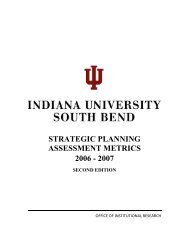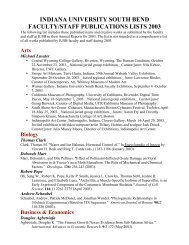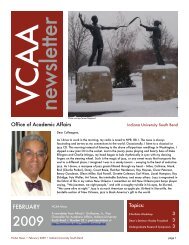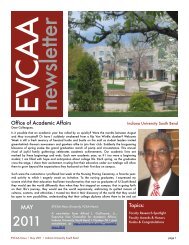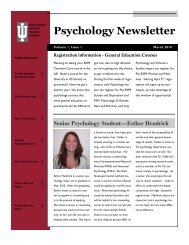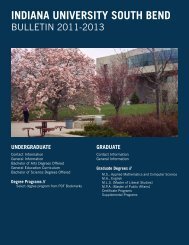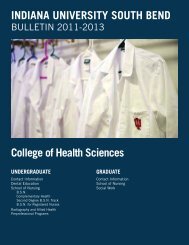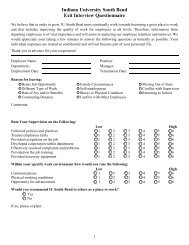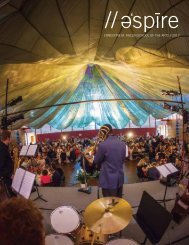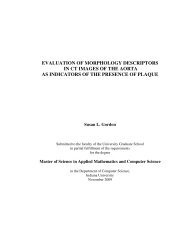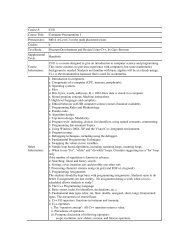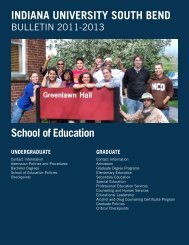Current version - Indiana University South Bend
Current version - Indiana University South Bend
Current version - Indiana University South Bend
Create successful ePaper yourself
Turn your PDF publications into a flip-book with our unique Google optimized e-Paper software.
3583 IU SOUTH BEND COURSE DESCRIPTIONS<br />
MATH-T 101<br />
Mathematics for Elementary<br />
Teachers 1 (3 cr.)<br />
P: MATH-M 14 or equivalent, or Level 3<br />
on mathematics placement examination.<br />
The foundations of arithmetic, including<br />
elements of set theory, numeration<br />
systems, operations, elementary number<br />
theory, integers, and rational numbers.<br />
Emphasis is on explaining, illustrating,<br />
and communicating mathematical ideas.<br />
Does not satisfy liberal arts and sciences<br />
general-education requirement. I, II, S<br />
MATH-T 436<br />
SECONDARY MATHEMATICS FOR<br />
TEACHERS (3 cr.)<br />
P: MATH-M 216 and one 300-level<br />
mathematics course. Emphasizes<br />
developing a deeper understanding of<br />
secondary mathematics by examining<br />
its fundamental ideas from an advanced<br />
perspective. Topics selected from real<br />
and complex number systems, functions,<br />
equations, integers, polynomials,<br />
congruence, distance and similarity, area<br />
and volume, and trigonometry.<br />
MATH-T 102<br />
MATH-T 103<br />
MATH-T 201<br />
MATH-T 336<br />
Mathematics for Elementary<br />
Teachers 2 (3 cr.)<br />
P: C or higher in MATH-T 101. Real<br />
numbers, equations, and inequalities,<br />
functions and graphs, measurement<br />
concepts, problem-solving elementary<br />
combinatorics, probability, and statistics.<br />
Emphasis is on applying problem-solving<br />
strategies in a variety of mathematical<br />
situations. Does not satisfy liberal arts and<br />
sciences general-education requirement.<br />
I, II, S<br />
Mathematics for Elementary<br />
Teachers 3 (3 cr.)<br />
P: C or higher in MATH-T 101. Topics<br />
include analysis and measurement of twoand<br />
three-dimensional figures; congruent<br />
and similar triangles, compass and<br />
straight-edge constructions. Emphasis is<br />
on the transition from visual and informal<br />
reasoning to formal reasoning about<br />
geometric objects and relationships.<br />
Does not satisfy liberal arts and sciences<br />
general-education requirement. I, II, S<br />
MATHEMATICS FOR ELEMENTARY<br />
TEACHERS VIA problem solving (3 cr.)<br />
P: Either C or higher in MATH-T 102<br />
and MATH-T 103; or MATH-M 118 and<br />
MATH-M 125; or consent of instructor.<br />
Provides experiences in mathematical<br />
problem solving for future teachers of<br />
mathematics, and for others interested<br />
in mathematical thinking. Exploration<br />
and development of the general processes<br />
of mathematical thinking, including<br />
monitoring and reflection, conjecturing,<br />
justifying and convincing.<br />
TOPICS IN EUCLIDEAN GEOMETRY (3 CR.)<br />
P: MATH-M 301. A study of the central<br />
aspects of two-dimensional Euclidean<br />
geometry from historical and axiomatic<br />
points of view as well as through handson<br />
and/or computer-based explorations<br />
of geometric concepts and constructions.<br />
II (even years)<br />
MATH-T 490 Topics for Elementary Teachers (3<br />
cr.)<br />
P: MATH-T 103. Development and study<br />
of a body of mathematics specifically<br />
designed for experienced elementary<br />
teachers. Examples include probability,<br />
statistics, geometry, and algebra. Open<br />
only to graduate elementary teachers.<br />
MICR: Microbiology<br />
See ANAT, BIOL, PHSL, and PLSC for additional<br />
biological sciences courses.<br />
MICR-M 250<br />
MICR-M 255<br />
MICR-M 310<br />
MICR-M 315<br />
Microbial Cell Biology (3 cr.)<br />
P: CHEM-C 102. Introduction to<br />
microorganisms: cytology, nutrition,<br />
reproduction, and physiology. Importance<br />
of microorganisms in infectious disease.<br />
Host defense mechanisms against<br />
disease. Credit not allowed toward a<br />
biology major. I, II, S<br />
Microbiology Laboratory (2 cr.)<br />
P: CHEM-C 102; P or concurrent:<br />
MICR-M 250. Exercises in the principles<br />
and techniques of microscopy,<br />
cultivation, identification and detection<br />
of microorganisms. Credit not allowed<br />
toward a biology major. I, II, S<br />
Microbiology (3 cr.)<br />
P: BIOL-L 101, BIOL-L 102, BIOL-L<br />
211, CHEM-C 341. Application of<br />
fundamental biological principles to the<br />
study of microorganisms. Significance<br />
of microorganisms to humans and their<br />
environment. II<br />
Microbiology Laboratory (2 cr.)<br />
P or concurrent: MICR-M 310. Exercises<br />
and demonstrations in principles and<br />
techniques of cultivation and utilization<br />
of microorganisms. II<br />
P = Prerequisite, R = Recommended, C = Concomitant, VT = Variable Title<br />
I = fall semester, II = spring semester, S = summer session(s)



